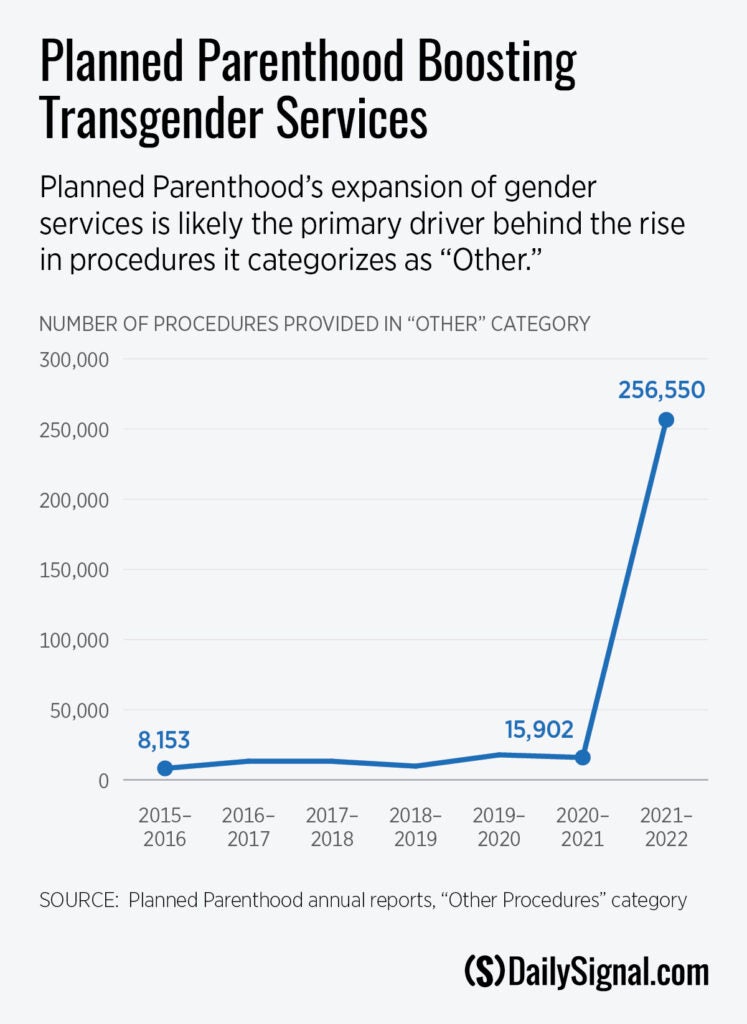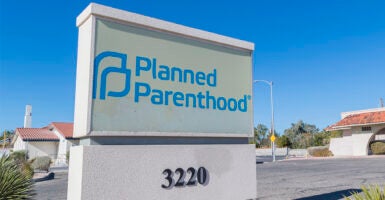Planned Parenthood’s 2021-2022 annual report is out: Taxpayer funding is at an all-time high and abortion remains a key priority. Meanwhile, visits for actual health care—like cancer screening and prevention services and prenatal care—continue to decline. The abortion giant has also been diversifying its portfolio of services, trying to corner the market in so-called transgender services.
The Supreme Court’s Dobbs v. Jackson Women’s Health Organization decision, which overturned Roe v. Wade last summer, will loom large over any analysis of abortion data. But this annual report actually covers health-related data from 2020 and 2021 and financial data for only part of 2022. That means we’re still many months away from seeing how Roe’s demise is affecting Planned Parenthood’s abortion numbers—and its bottom line.
The data we have now is important, though. Here are some key takeaways you should know.
In the medical data section, Planned Parenthood reported:
- 374,155 abortions, slightly down from the previous year’s all-time high of 383,460 abortions.
- 470,419 breast screenings and Pap tests, up from 373,755 the previous year.
- 187,234 preventive care visits, down from 127,095 the previous year (a year in which these services appear to have been characterized as well-woman exams).
- 1,803 adoption referrals, down from 1,940 the previous year and less than half of the 4,279 reported just three years ago.
Planned Parenthood performed 208 abortions for every adoption referral. Meanwhile, the number of patients Planned Parenthood saw (2.13 million) declined yet again.
The Charlotte Lozier Institute, a pro-life research and education organization, points out the shocking long-term decline in actual health services. Since 2010, breast exams are down 74%, Pap tests are down 70%, prenatal services are down 85%, and contraceptive services are down 36%.
On the financial side of things, the contrast is striking. Planned Parenthood reported:
- $2.3 billion in net assets, up from $2.1 billion the previous year.
- $670.4 million in government funding, up from $633.4 million the previous year.
- $1.9 billion in total revenue, up from $1.7 billion the previous year.
- $204.7 million in excess revenue (calculated by subtracting total expenses from total revenue), up from $133.7 million the previous year.
- 727,000 active individual contributors, up from 590,000 the previous year.
The Dobbs decision came down on June 24, 2022. This financial data covers up to June 30, 2022. So, while the financial data is more up to date than the report’s medical data, we still can’t know the full effect of the Dobbs decision on Planned Parenthood’s bottom line.
We know plenty about the changing abortion policy landscape post-Dobbs, though. Over a dozen states now protect women and unborn children through all nine months of pregnancy, with still more states providing strong protections that are in effect or under litigation. Abortion clinics in pro-life states have stopped doing abortions or moved to abortion-friendly states. Planned Parenthood’s national office has announced layoffs—to the tune of about 100 employees—coming this month.
Planned Parenthood has also revealed its game plan going forward. It will increase funding for things like sexually transmitted disease testing, contraception, and so-called gender-affirming care.
Planned Parenthood’s aggressive buy-in on radical gender ideology isn’t new. Long before Dobbs, the abortion giant was methodically diversifying its portfolio of offerings. But the numbers reveal just how quickly Planned Parenthood is cornering its share of the market.
Planned Parenthood first mentioned providing “hormone treatments for transgender patients” in its 2014-2015 annual report. It had 26 centers in 10 states providing these interventions.
In the latest report, Planned Parenthood says that “41 affiliates provide gender-affirming hormone therapy.” And when you look at the data, the numbers are even more shocking.

The meteoric rise in the “Other Services” category is astounding. And by Planned Parenthood’s own admission (it isn’t exactly making the press rounds bragging about providing other types of services in this category), we know that transgender “health care” makes up the bulk of the dramatic rise.
Planned Parenthood doesn’t provide a breakdown of transgender services alone. They’re buried in the “Other Services” category, bundled in a sub-category called “Other Procedures.” This category includes things like pediatric care, preventive care, and infertility services.
“Services” are counted by “discreet clinical interactions,” not by the number of individual patients. If Planned Parenthood gave one patient a free condom, a pregnancy test, a sexually transmitted infection test, and an abortion over the course of a year, that would count as four different services.
This is how Planned Parenthood downplays how central abortion is to its business: It muddies the math by giving an abortion procedure the same weight as providing a simple pregnancy test or free condom—they are all counted as one “service.”
Moving forward in a post-Dobbs landscape, expect to see Planned Parenthood aggressively continue its abortion activity in liberal states. And everywhere Planned Parenthood has a footprint—even if it isn’t performing abortions there—you can bet that transgender services are (or will probably someday be) on the menu.
Congress, for its part, has a long to-do list to protect life in a post-Dobbs world. The Heritage Foundation has provided a road map for how to get started. At the very least, Congress should defund Planned Parenthood. This could be done through the Protecting Life and Taxpayers Act. It would require that groups seeking federal funding certify that they won’t perform abortions or fund other entities that do.
Federal policymakers have an opportunity to advance robust pro-life policies in the 118th Congress. Making sure Planned Parenthood doesn’t get another penny of taxpayers’ hard-earned money should be a priority.
Have an opinion about this article? To sound off, please email [email protected], and we’ll consider publishing your edited remarks in our regular “We Hear You” feature. Remember to include the URL or headline of the article plus your name and town and/or state.































